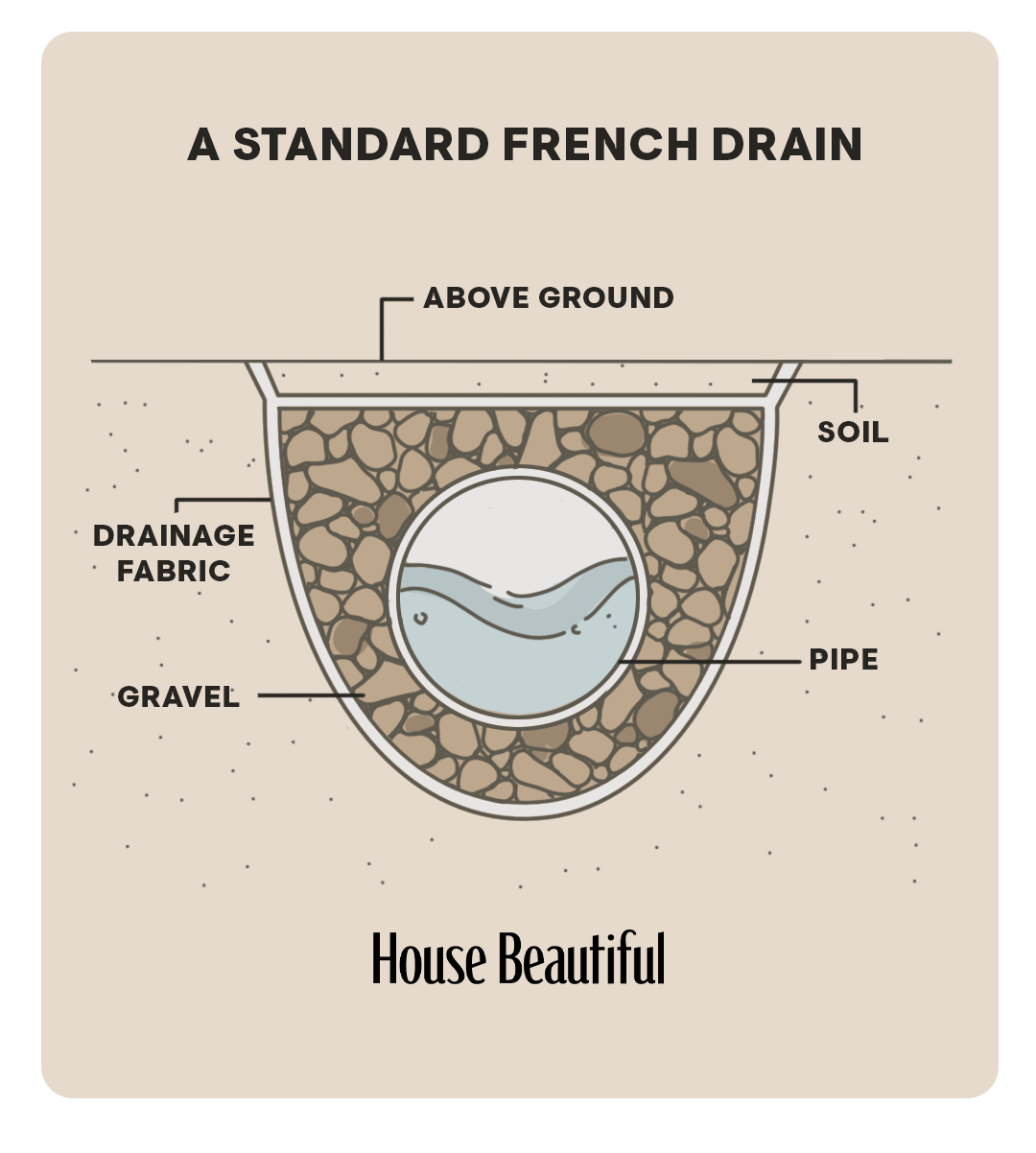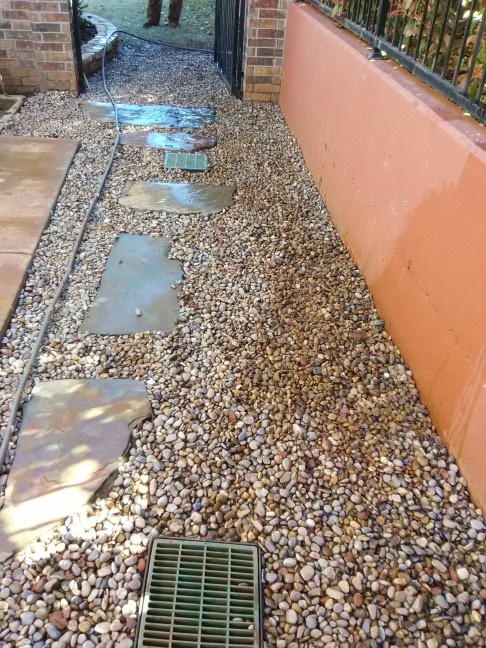Discover Why You Should Consider a Portland French Drain for Landscape Drainage Issues
Discover Why You Should Consider a Portland French Drain for Landscape Drainage Issues
Blog Article
The Necessary Overview to Keeping Your French Drainpipe for Durable Performance
Keeping your French drain is vital to its effectiveness and your building's defense. Normal checks can save you from pricey repairs and water damage. You'll would like to know what signs to look for and how typically to evaluate your system. And also, recognizing the cleansing process can make a significant difference. Allow's discover the necessary steps for ensuring your drainpipe operates well for years to come.
Understanding the Feature of a French Drainpipe
A French drain is an important part in taking care of water around your home. It routes excess water away from your foundation, protecting against flooding and damages. When hefty rain falls, the drainpipe accumulates water through a perforated pipeline buried in crushed rock. This system enables water to stream easily, decreasing pressure on your cellar walls and minimizing the threat of leaks.You may wonder just how it functions in practice. As water fills the soil, gravity pulls it towards the drain. The perforated pipeline captures this water, transporting it to a marked drain location or storm sewage system. This process keeps your lawn dry and secures your home's structural integrity.Understanding just how a French drain features is key to valuing its significance. By effectively funneling water away, it helps keep a safe and completely dry living environment. So, maintaining your French drain in leading condition assurances you avoid pricey repair work down the line.
Routine Examinations: What to Try to find
When you're inspecting your French drain, begin by inspecting for any type of obstructions that could be blocking water circulation. Focus on signs of surface disintegration around the drainpipe, as this can indicate prospective concerns. Regular evaluations will assist maintain your water drainage system operating successfully.
Clogged Drain Evaluation
Just how can you tell if your French drainpipe is obstructed? Initially, expect water merging in your backyard, especially after hefty rain. If you observe areas where water collects rather than draining, that's a red flag. You need to additionally examine the drainpipe outlet; if water isn't streaming out as it should, there's likely an obstruction. Listen for unusual gurgling sounds, which can show trapped air. In addition, evaluate the drainpipe's surface area for any type of greenery growth, as origins can block the system and infiltrate. If you smell musty smells, it might point to stagnant water triggered by a clog. Frequently examining these indications can help you keep your French drain successfully and protect against expensive repair work.
Surface Erosion Examine

Cleansing Your French Drainpipe: Step-by-Step Overview
Cleaning your French drain is necessary for keeping it operating correctly. You'll require some certain devices and a clear procedure to assure everything runs efficiently. Allow's walk through the steps and ideas for maintaining your drain effectively.
Tools You'll Require
To take on the task of cleansing your French drain properly, you'll wish to gather a couple of important devices. Grab a sturdy pair of gloves to shield your hands from particles and sharp things. A small shovel or trowel will assist you get rid of dust or clogs around the drainpipe. For cleaning out the interior, a plumbing professional's serpent or a high-pressure water nozzle can be incredibly useful. You'll also need a bucket for collecting any debris you pull out. Finally, having a yard hose on hand will make it easier to rinse out the drainpipe and assure it's flowing efficiently. With these devices prepared, you'll be set for a complete cleaning session!
Cleansing Refine Actions
Begin by examining the area around your French drain for any kind of noticeable debris or blockages. Remove fallen leaves, branches, or dirt that may obstruct water flow. Next off, inspect the inlet and outlet areas; clear any kind of blockages to guarantee correct drain. Use a garden pipe to flush the drain, routing water right into the inlet. This helps remove any accumulated sludge or debris. Think about using a plumber's serpent to break them up if you discover relentless obstructions. After cleaning, check the crushed rock around the drain; replenish it if it's cleaned away. Ultimately, validate the drain covers are undamaged and safely in position to avoid debris from getting in. Routine cleansing maintains your French drainpipe functioning efficiently.
Maintenance Frequency Tips
While routine maintenance is important for your French drainpipe's long life, recognizing just how frequently to maintain it can make all the difference. Ideally, you ought to check your French drain at the very least two times a year, ideally in springtime and loss. After heavy rains or snowmelt, look for clogs or debris. If you discover any type of standing water, it's their website time to cleanse your drain.In areas with heavy foliage, even more regular upkeep-- concerning every three months-- might be necessary. Additionally, take into consideration cleaning your French drain after major tornados or if you observe water pooling in your lawn. By remaining positive, you'll ensure your French drain features efficiently and protects your building from water damages. Routine checks will certainly conserve you money and time in the long run.
Recognizing Typical Concerns and Their Solutions
When you see water merging in your backyard or damp areas in your basement, it's vital to identify typical concerns with your French drain and execute efficient options. One regular problem is blocking, commonly caused by debris like leaves or sediment. To fix this, you can utilize a pipes serpent or a high-pressure water jet to clear blockages.Another concern may be incorrect slope. If your drain isn't sloped correctly, water won't flow away from your home. You can change the incline by digging and rearranging the drainpipe pipe.Lastly, look for damages or cracks in the drain itself. Changing the damaged areas is vital for peak efficiency if you find any type of. By dealing with these concerns immediately, you'll assist ensure that your French drain remains to operate successfully, safeguarding your property from water damages and preserving a dry, secure environment.
Seasonal Maintenance Tips for Your French Drain
Dealing with common concerns with your French drain is simply the initial step in ensuring its long-lasting performance. Seasonal upkeep is vital for peak performance. In the springtime, remove leaves and particles that might have built up throughout winter months. Look for any kind of clogs in the electrical outlet or capture container, as water needs a clear course to stream freely.During summer, examine your drainpipe for any signs of resolving or changing dirt. Make certain it's still level and functioning appropriately. As autumn methods, clean out any fallen entrusts to protect against clogs before winter season arrives.In winter season, expect freezing temperature levels. If you live in a cool environment, make certain your drain isn't in danger of cold. Shielding exposed pipes can help. Routine checks and prompt upkeep can protect against costly repair work and keep your French drain working properly year-round. Remain aggressive and enjoy tranquility of mind recognizing your drain system is in good form!
When to Contact a Professional
When to call in an expert can save you time and protect against further damages to your French drain, understanding. It's a clear indicator that your drainpipe may be obstructed or harmed if you see persistent standing water in your yard. Do not neglect odd odors, as they can suggest sewage backup or decay, which requires prompt attention.If you locate that your drain isn't functioning properly after efforts to clean or preserve it, it's time to connect for professional assistance. In addition, if you're not sure regarding the underlying issues or lack the essential devices, hiring a specialist can offer tranquility of mind.Finally, if your French drainpipe is old or has experienced considerable deterioration, specialist analysis can determine whether repair services or complete replacement is needed. Trust the specialists to guarantee your water drainage system works efficiently for several years ahead.
Tips for Preventing Future Drain Issues
To maintain your French drainpipe operating efficiently, routinely inspecting and keeping it can make all the difference. Begin by removing debris, leaves, and dust from the surface and drain openings. This prevents obstructions that can bring about water backup. Check the gravel around the drain; if it's compacted or deteriorated, consider adding fresh crushed rock to maintain suitable flow.Next, divert water away from your drainpipe by ensuring downspouts and seamless gutters are clear more and routing water at the very least three feet away from your structure. Routinely check for any kind of signs of damage or sagging. If you observe concerns, resolve them immediately.Finally, consider setting up a catch or a filter container to catch bigger debris before it enters the drain. By staying positive with these ideas, you'll decrease the threat of future drainage issues and maintain your French drainpipe in leading form.
Often Asked Inquiries
Exactly how Long Does a French Drain Commonly Last?
A French drainpipe typically lasts around 30 to 40 years, depending on the materials made use of and upkeep (Portland French Drain). If you stay on par with routine checks, you can prolong its life expectancy even additionally
Can I Set Up a French Drain Myself?
Yes, you can install a French drain yourself if you have actually obtained the right devices and understanding. Just make specific to plan thoroughly, follow local regulations, and guarantee correct water drainage to prevent future problems.
What Materials Are Used in a French Drainpipe?
You'll require perforated pipe, gravel, landscape textile, and a solid drainage pipe for your French drainpipe. These materials help reroute water efficiently, protecting against flooding and keeping your residential property secure and completely dry from water damage.

Is an Authorization Required to Mount a French Drainpipe?
You'll likely need a permit to install a French drainpipe, depending on local policies. Contact your district to guarantee you follow any kind of necessary guidelines and stay clear of potential issues throughout installment.
What Are the Prices Connected With French Drainpipe Upkeep?
Preserving a French drain usually sets you back in between $100 and $500 each year. You'll require to take right into account costs for cleaning, repairs, and examinations. Routine upkeep assists stop bigger warranties and costs your system works correctly for years - Portland French Drain. When you're inspecting your French drainpipe, begin this by checking for any obstructions that may be obstructing water circulation. By staying proactive, you'll assure your French drainpipe functions properly and secures your building from water damage. When you notice water merging in your yard or damp places in your basement, it's vital to recognize common concerns with your French drain and implement reliable solutions. You can readjust the slope by excavating and repositioning the drainpipe pipe.Lastly, check for damage or cracks in the drainpipe itself. Check the crushed rock around the drainpipe; if it's compressed or eroded, take into consideration adding fresh crushed rock to maintain excellent flow.Next, divert water away from your drainpipe by guaranteeing gutters and downspouts are clear and routing water at least 3 feet away from your foundation
Report this page